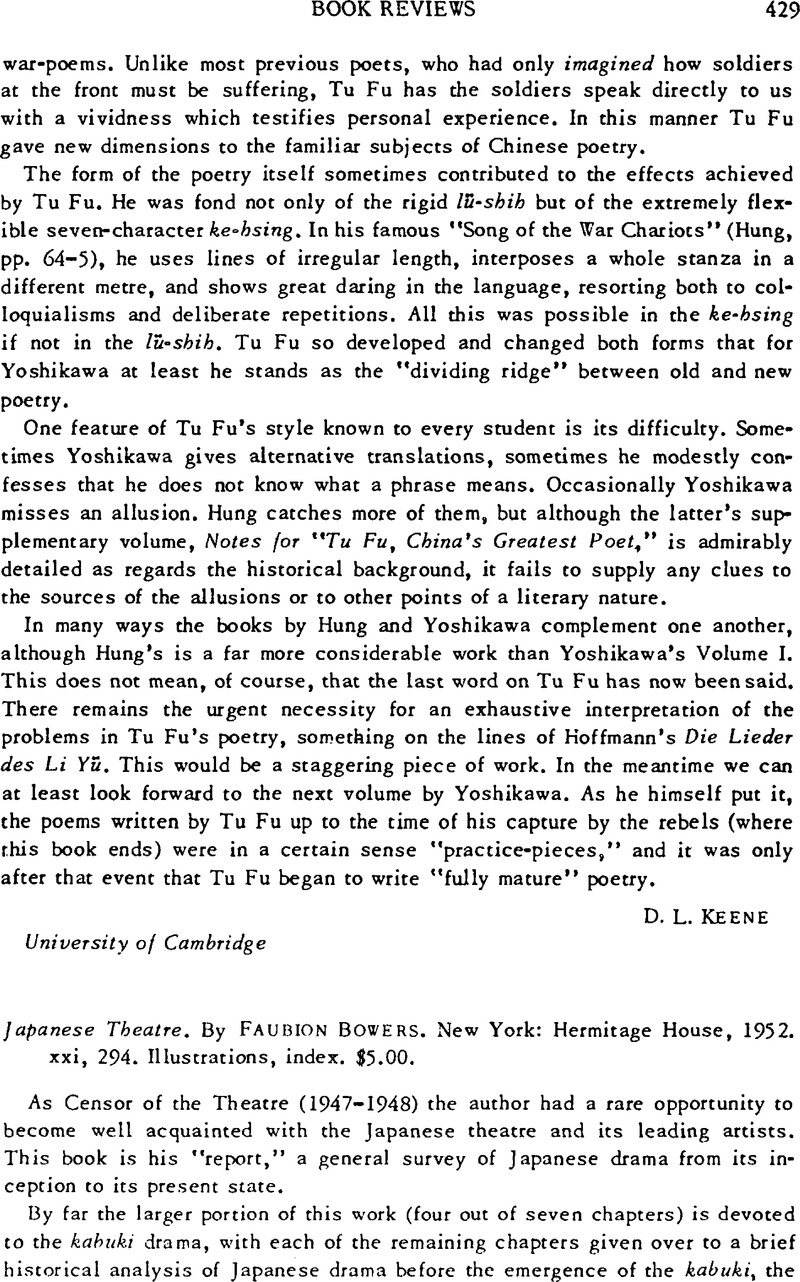No CrossRef data available.
Article contents
Japanese Theatre. By Faubion Bowers. New York: Hermitage House, 1952. xxi, 294. Illustrations, index. $5.00.
Published online by Cambridge University Press: 23 March 2011
Abstract

- Type
- Book Reviews
- Information
- Copyright
- Copyright © The Association for Asian Studies, Inc. 1953
References
1 The three plays are Tsuchigumo, an adaptation of the nō play by the same title; Sessbū Gappō ga Tsuji, an adaptation of the puppet play with an identical title and Sukeroku yukari no Edo zakura, an original kabuki play. While the first play follows the nō play very closely, the second deals with only the last “scene” of the puppet play which can be found in jōruri Meisakushū, Nihon meicho zenshū, Vol. 7.682–710, 1929Google Scholar, Tokyo. The third play is given in Kawatake Shigetoshi, Kabuki meisaku shū, ge, 398–523, Hyōshaku Edobungaku sōsho, 1935–1938, Tokyo. The first “scene” of this play is omitted in translation.
2 The author's description of the following are unreliable, either in part or in their entirety: the well-known episode from the Kojiki about the ritual dance of Ame no Uzume no mikoto (pp. 3–4); the meaning of the character saru of sarugaku (p. 15); the genesis of the term bunraku (p. 32) [See Yasuji, Wakatsuki, Nihon jōrurishi no kenkyū, 969–971, Tokyo, 1943Google Scholar]; relationship between the nengō (“Era name” and the postumous title of the Emperor (p. 43); social classification of the commoners in the Tokugawa period (p. 44); the “policy platform” of the “Theatrical Reform Group” in 1886 (pp. 203–204) [See Tarō, Akiba, Tōto Meiji engekishi, 171–174, Tokyo, 1937Google Scholar]; the historic performance in the presence of the Emperor Meiji (p. 208), see Akiba, ibid., 189–192. Hōjō Takatoki was Shikken (“Regent”), not Shōgun. The author must mean that there are about two hundred and fifty nō plays in the current repertoire, not “still in existence” (p. 15). Shidai and michiyuki are two entirely different things, serving different artistic aims (p. 18). For Bunrakuen read Bunrakuken; for Okura read Daizō (p. 32); for Tachimatsu Hachirobei read Tatsumatsu Hachirōbei (p. 33); for Toyotomi Hideyasu read Yūki Hideyasu (p. 42); for “Liberal Group (Jiyu Dantai)” read Liberal Party (jiyūtō), whose leader Itagaki was hardly “the chief formulator of the Meiji Constitution” (p. 209). Tsubouchi Shōyō, contrary to popular belief, did not “found” the Bungei kyōkai, but was pretty much forced into accepting the directorship (p. 212) [See Akiba, , op. cit., 440–442Google Scholar]. Tsubouchi did not write in 1893 or any other time, so far as I know, a History of the Japanese Theatre (p. 213). What he did write, however, was a series of short studies entitled Wagakuni no shigeki, or “Historical Drama of Our Nation” which, unfortunately, were left unfinished.
3 Kagekiyo can be found in Shigetoshi, Kawatake, op. cit., 84–118Google Scholar. See also p. 5ff. for a brief discussion on the Kabuki jūhachiban. For Kedatsu read Gedatsu; for Kamabige read Kamahige; for Oshimo Doshi read Oshimodoshi.
4 See Shigetoshi, Kawatake, Kabukishi no kenkyū, 179–182, Tokyo, 1948.Google Scholar




